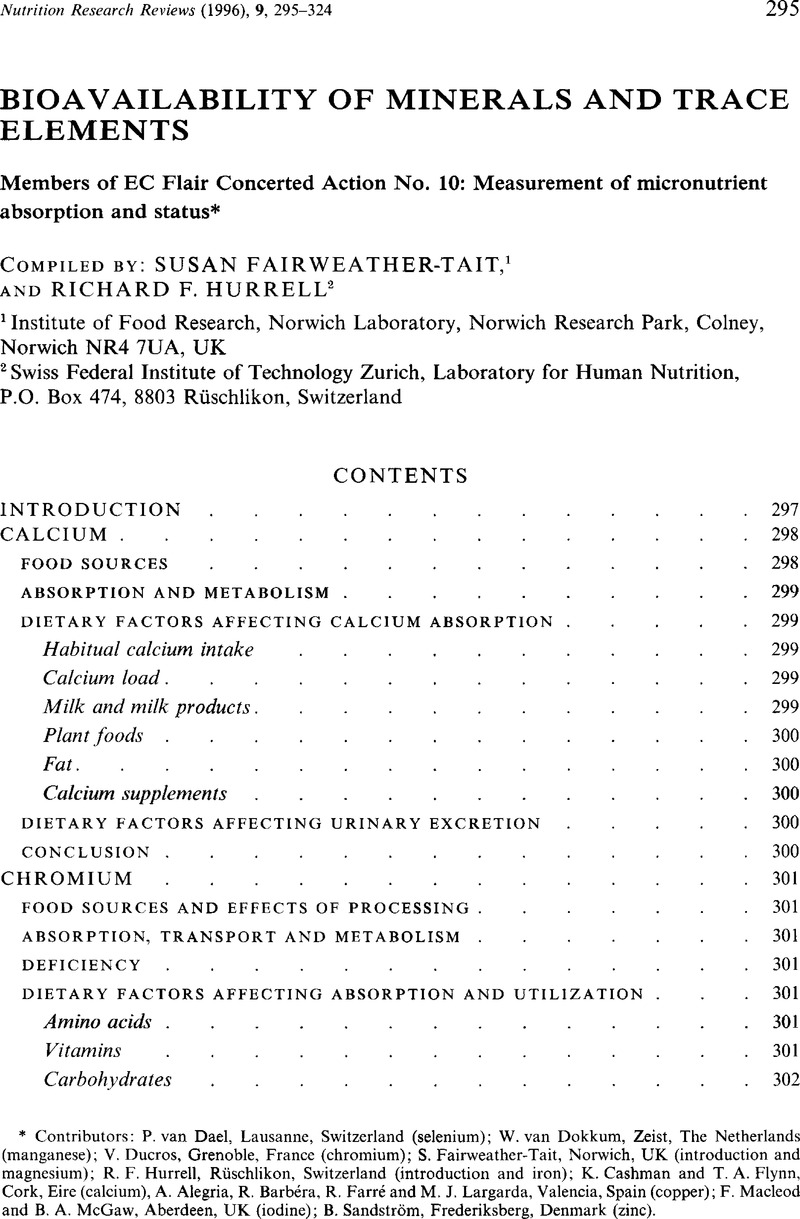Crossref Citations
This article has been cited by the following publications. This list is generated based on data provided by Crossref.
Davies, Jill
and
Lightowler, Helen
1997.
The National Food Guide: how relevant is it to vegans?.
Nutrition & Food Science,
Vol. 97,
Issue. 5,
p.
168.
Oskarsson, Agneta
and
Norrgren, Leif
1998.
Copper pipes as a source of copper exposure in man and environment.
Environmental Reviews,
Vol. 6,
Issue. 3-4,
p.
139.
Crews, H.M.
1998.
Speciation of trace elements in foods, with special reference to cadmium and selenium: is it necessary?.
Spectrochimica Acta Part B: Atomic Spectroscopy,
Vol. 53,
Issue. 2,
p.
213.
García, R.
Alegría, A.
Barberá, R.
Farre, R.
and
Lagarda, M. J.
1998.
Dialyzability of iron, zinc, and copper of different types of infant formulas marketed in Spain.
Biological Trace Element Research,
Vol. 65,
Issue. 1,
p.
7.
Ohno, Yoshimi
Hirai, Kazuko
Nagata, Kumiko
Tamura, Toshihide
Rai, Shiva K.
Onta, Sharad
Devkota, Madhu
and
Shrestha, Mathura P.
1998.
Evaluation of the iron status in Nepalese living in Southern Nepal.
Nutrition Research,
Vol. 18,
Issue. 11,
p.
1847.
Sanchez-Castillo, Claudia P.
Dewey, Peter J.S.
Aguirre, Antonia
Lara, Jose J.
Vaca, Rebeca
Leon de la Barra, Patricia
Ortiz, Margarita
Escamilla, Ismael
and
James, W.Philip T.
1998.
The Mineral Content of Mexican Fruits and Vegetables.
Journal of Food Composition and Analysis,
Vol. 11,
Issue. 4,
p.
340.
Davidsson, L
Walczyk, T
Morris, A
and
Hurrell, RF
1998.
Influence of ascorbic acid on iron absorption from an iron-fortified, chocolate-flavored milk drink in Jamaican children.
The American Journal of Clinical Nutrition,
Vol. 67,
Issue. 5,
p.
873.
Van Dael, P.
Barclay, D.
Longet, K.
Metairon, S.
and
Fay, L.B.
1998.
Determination of selenium stable isotopes by gas chromatography–mass spectrometry with negative chemical ionisation.
Journal of Chromatography B: Biomedical Sciences and Applications,
Vol. 715,
Issue. 2,
p.
341.
House, William A.
1999.
Trace element bioavailability as exemplified by iron and zinc.
Field Crops Research,
Vol. 60,
Issue. 1-2,
p.
115.
Gibson, Rosalind S.
and
Hotz, Christine
2000.
The Adequacy of Micronutrients in Complementary Foods.
Pediatrics,
Vol. 106,
Issue. Supplement_4,
p.
1298.
Thane, CW
Walmsley, CM
Bates, CJ
Prentice, A
and
Cole, TJ
2000.
Risk factors for poor iron status in British toddlers: further analysis of data from the National Diet and Nutrition Survey of children aged 1.5–4.5 years.
Public Health Nutrition,
Vol. 3,
Issue. 4,
p.
433.
Frossard, Emmanuel
Bucher, Marcel
M�chler, Felix
Mozafar, Ahmad
and
Hurrell, Richard
2000.
Potential for increasing the content and bioavailability of Fe, Zn and Ca in plants for human nutrition.
Journal of the Science of Food and Agriculture,
Vol. 80,
Issue. 7,
p.
861.
Sugiura, S H
Babbitt, J K
Dong, F M
and
Hardy, R W
2000.
Utilization of fish and animal by-product meals in low-pollution feeds for rainbow troutOncorhynchus mykiss(Walbaum).
Aquaculture Research,
Vol. 31,
Issue. 7,
p.
585.
Yamashiro, Y.
2000.
Overview of Complementary Feeding (Weaning) in Countries of Asia.
Pediatrics,
Vol. 106,
Issue. Supplement_4,
p.
1274.
Schiavon, S.
Bailoni, L.
Ramanzin, M.
Vincenzi, R.
Simonetto, A.
and
Bittante, G.
2000.
Effect of proteinate or sulphate mineral sources on trace elements in blood and liver of piglets.
Animal Science,
Vol. 71,
Issue. 1,
p.
131.
Sebastiá, Vicente
Barberá, Reyes
Farré, Rosaura
and
Lagarda, María Jesús
2001.
Effects of legume processing on calcium, iron and zinc contents and dialysabilities.
Journal of the Science of Food and Agriculture,
Vol. 81,
Issue. 12,
p.
1180.
Stadlober, Monika
Sager, Manfred
and
Irgolic, Kurt Johann
2001.
Effects of selenate supplemented fertilisation on the selenium level of cereals — identification and quantification of selenium compounds by HPLC–ICP–MS.
Food Chemistry,
Vol. 73,
Issue. 3,
p.
357.
Graham, Robin D.
Welch, Ross M.
and
Bouis, Howarth E.
2001.
Vol. 70,
Issue. ,
p.
77.
Jovaní, M.
Barberá, R.
and
Farré, R.
2001.
Review: Effect of Some Components of Milk- and Soy-Based Infant Formulas on Mineral Bioavailability.
Food Science and Technology International,
Vol. 7,
Issue. 3,
p.
191.
Fairweather-Tait, Susan J.
2002.
Trace Elements in Man and Animals 10.
p.
255.





